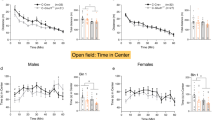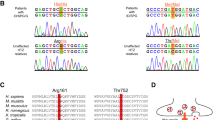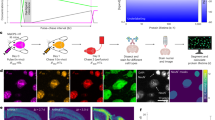Abstract
Rett syndrome (RTT) is a severe neurodevelopmental disorder associated with mutations in either MECP2, CDKL5 or FOXG1. The precise molecular mechanisms that lead to the pathogenesis of RTT have yet to be elucidated. We recently reported that expression of GluD1 (orphan glutamate receptor δ-1 subunit) is increased in iPSC-derived neurons obtained from patients with mutations in either MECP2 or CDKL5. GluD1 controls synaptic differentiation and shifts the balance between excitatory and inhibitory synapses toward the latter. Thus, an increase in GluD1 might be a critical factor in the etiology of RTT by affecting the excitatory/inhibitory balance in the developing brain. To test this hypothesis, we generated iPSC-derived neurons from FOXG1+/− patients. We analyzed mRNA and protein levels of GluD1 together with key markers of excitatory and inhibitory synapses in these iPSC-derived neurons and in Foxg1+/− mouse fetal (E11.5) and adult (P70) brains. We found strong correlation between iPSC-derived neurons and fetal mouse brains, where GluD1 and inhibitory synaptic markers (GAD67 and GABA AR-α1) were increased, whereas the levels of a number of excitatory synaptic markers (VGLUT1, GluA1, GluN1 and PSD-95) were decreased. In adult mice, GluD1 was decreased along with all GABAergic and glutamatergic markers. Our findings further the understanding of the etiology of RTT by introducing a new pathological event occurring in the brain of FOXG1+/− patients during embryonic development and its time-dependent shift toward a general decrease in brain synapses.
Similar content being viewed by others
Log in or create a free account to read this content
Gain free access to this article, as well as selected content from this journal and more on nature.com
or
References
Chahrour M, Zoghbi HY : The story of Rett syndrome: from clinic to neurobiology. Neuron 2007; 56: 422–437.
Ariani F, Hayek G, Rondinella D et al: FOXG1 is responsible for the congenital variant of Rett syndrome. Am J Hum Genet 2008; 83: 89–93.
Bertani I, Rusconi L, Bolognese F et al: Functional consequences of mutations in CDKL5, an X-linked gene involved in infantile spasms and mental retardation. J Biol Chem 2006; 281: 32048–32056.
Mencarelli MA, Spanhol-Rosseto A, Artuso R et al: Novel FOXG1 mutations associated with the congenital variant of Rett syndrome. J Med Genet 2010; 47: 49–53.
Le Guen T, Bahi-Buisson N, Nectoux J et al: A FOXG1 mutation in a boy with congenital variant of Rett syndrome. Neurogenetics 2011; 12: 1–8.
Tian C, Gong Y, Yang Y et al: Foxg1 has an essential role in postnatal development of the dentate gyrus. J Neurosci 2012; 32: 2931–2949.
Eagleson KL, Schlueter McFadyen-Ketchum LJ, Ahrens ET et al: Disruption of Foxg1 expression by knock-in of cre recombinase: effects on the development of the mouse telencephalon. Neuroscience 2007; 148: 385–399.
Xuan S, Baptista CA, Balas G, Tao W, Soares VC, Lai E : Winged helix transcription factor BF-1 is essential for the development of the cerebral hemispheres. Neuron 1995; 14: 1141–1152.
Shen L, Nam HS, Song P, Moore H, Anderson SA : FoxG1 haploinsufficiency results in impaired neurogenesis in the postnatal hippocampus and contextual memory deficits. Hippocampus 2006; 16: 875–890.
Esmailpour T, Huang TS : TBX3 promotes human embryonic stem cell proliferation and neuroepithelial differentiation in a differentiation stage-dependent manner. Stem Cells 2012; 30: 2152–2163.
Shibata M, Kurokawa D, Nakao H, Ohmura T, Aizawa S : MicroRNA-9 modulates Cajal-Retzius cell differentiation by suppressing Foxg1 expression in mouse medial pallium. J Neurosci 2008; 28: 10415–10421.
Dastidar SG, Landrieu PM, D'Mello SR : FoxG1 promotes the survival of postmitotic neurons. J Neurosci 2011; 31: 402–413.
Martynoga B, Morrison H, Price DJ, Mason JO : Foxg1 is required for specification of ventral telencephalon and region-specific regulation of dorsal telencephalic precursor proliferation and apoptosis. Dev Biol 2005; 283: 113–127.
Brunetti-Pierri N, Paciorkowski AR, Ciccone R et al: Duplications of FOXG1 in 14q12 are associated with developmental epilepsy, mental retardation, and severe speech impairment. Eur J Hum Genet 2011; 19: 102–107.
Pontrelli G, Cappelletti S, Claps D et al: Epilepsy in patients with duplications of chromosome 14 harboring FOXG1. Pediatr Neurol 2014; 50: 530–535.
Brancaccio M, Pivetta C, Granzotto M, Filippis C, Mallamaci A : Emx2 and Foxg1 inhibit gliogenesis and promote neuronogenesis. Stem Cells 2010; 28: 1206–1218.
Raciti M, Granzotto M, Duc MD et al: Reprogramming fibroblasts to neural-precursor-like cells by structured overexpression of pallial patterning genes. Mol Cell Neurosci 2013; 57: 42–53.
Fasano CA, Phoenix TN, Kokovay E et al: Bmi-1 cooperates with Foxg1 to maintain neural stem cell self-renewal in the forebrain. Genes Dev 2009; 23: 561–574.
Yadirgi G, Leinster V, Acquati S, Bhagat H, Shakhova O, Marino S : Conditional activation of Bmi1 expression regulates self-renewal, apoptosis, and differentiation of neural stem/progenitor cells in vitro and in vivo. Stem Cells 2011; 29: 700–712.
Regad T, Roth M, Bredenkamp N, Illing N, Papalopulu N : The neural progenitor-specifying activity of FoxG1 is antagonistically regulated by CKI and FGF. Nat Cell Biol 2007; 9: 531–540.
Manuel MN, Martynoga B, Molinek MD et al: The transcription factor Foxg1 regulates telencephalic progenitor proliferation cell autonomously, in part by controlling Pax6 expression levels. Neural Dev 2011; 6: 9.
Pratt T, Quinn JC, Simpson TI, West JD, Mason JO, Price DJ : Disruption of early events in thalamocortical tract formation in mice lacking the transcription factors Pax6 or Foxg1. J Neurosci 2002; 22: 8523–8531.
Pratt T, Vitalis T, Warren N, Edgar JM, Mason JO, Price DJ : A role for Pax6 in the normal development of dorsal thalamus and its cortical connections. Development 2000; 127: 5167–5178.
Talamillo A, Quinn JC, Collinson JM et al: Pax6 regulates regional development and neuronal migration in the cerebral cortex. Dev Biol 2003; 255: 151–163.
Tyas DA, Pearson H, Rashbass P, Price DJ : Pax6 regulates cell adhesion during cortical development. Cereb Cortex 2003; 13: 612–619.
Livide G, Patriarchi T, Amenduni M et al: GluD1 is a common altered player in neuronal differentiation from both MECP2-mutated and CDKL5-mutated iPS cells. Eur J Hum Genet 2015; 23: 195–201.
Kuroyanagi T, Yokoyama M, Hirano T : Postsynaptic glutamate receptor delta family contributes to presynaptic terminal differentiation and establishment of synaptic transmission. Proc Natl Acad Sci USA 2009; 106: 4912–4916.
Yasumura M, Yoshida T, Lee SJ, Uemura T, Joo JY, Mishina M : Glutamate receptor delta1 induces preferentially inhibitory presynaptic differentiation of cortical neurons by interacting with neurexins through cerebellin precursor protein subtypes. J Neurochem 2012; 121: 705–716.
Ryu K, Yokoyama M, Yamashita M, Hirano T : Induction of excitatory and inhibitory presynaptic differentiation by GluD1. Biochem Biophys Res Commun 2012; 417: 157–161.
Konno K, Matsuda K, Nakamoto C et al: Enriched expression of GluD1 in higher brain regions and its involvement in parallel fiber-interneuron synapse formation in the cerebellum. J Neurosci 2014; 34: 7412–7424.
Cooper GM, Coe BP, Girirajan S et al: A copy number variation morbidity map of developmental delay. Nat Genet 2011; 43: 838–846.
Treutlein J, Muhleisen TW, Frank J et al: Dissection of phenotype reveals possible association between schizophrenia and Glutamate Receptor Delta 1 (GRID1) gene promoter. Schizophr Res 2009; 111: 123–130.
Pizzarelli R, Cherubini E : Alterations of GABAergic signaling in autism spectrum disorders. Neural Plast 2011; 2011: 297153.
Tabuchi K, Blundell J, Etherton MR et al: A neuroligin-3 mutation implicated in autism increases inhibitory synaptic transmission in mice. Science 2007; 318: 71–76.
Foldy C, Malenka RC, Sudhof TC : Autism-associated neuroligin-3 mutations commonly disrupt tonic endocannabinoid signaling. Neuron 2013; 78: 498–509.
Dracopoli N, Haines J, Korf B et al: Current Protocols in Molecular Biology. Hoboken, NJ, USA: John Wiley & Son, 2000.
Takahashi K, Tanabe K, Ohnuki M et al: Induction of pluripotent stem cells from adult human fibroblasts by defined factors. Cell 2007; 131: 861–872.
Kim JE, O'Sullivan ML, Sanchez CA et al: Investigating synapse formation and function using human pluripotent stem cell-derived neurons. Proc Natl Acad Sci USA 2011; 108: 3005–3010.
Yuan SH, Martin J, Elia J et al: Cell-surface marker signatures for the isolation of neural stem cells, glia and neurons derived from human pluripotent stem cells. PLoS One 2011; 6: e17540.
Hebert JM, McConnell SK : Targeting of cre to the Foxg1 (BF-1) locus mediates loxP recombination in the telencephalon and other developing head structures. Dev Biol 2000; 222: 296–306.
Siegenthaler JA, Tremper-Wells BA, Miller MW : Foxg1 haploinsufficiency reduces the population of cortical intermediate progenitor cells: effect of increased p21 expression. Cereb Cortex 2008; 18: 1865–1875.
Zhubi A, Chen Y, Dong E, Cook EH, Guidotti A, Grayson DR : Increased binding of MeCP2 to the GAD1 and RELN promoters may be mediated by an enrichment of 5-hmC in autism spectrum disorder (ASD) cerebellum. Transl Psychiatry 2014; 4: e349.
Dani VS, Chang Q, Maffei A, Turrigiano GG, Jaenisch R, Nelson SB : Reduced cortical activity due to a shift in the balance between excitation and inhibition in a mouse model of Rett syndrome. Proc Natl Acad Sci USA 2005; 102: 12560–12565.
Ricciardi S, Ungaro F, Hambrock M et al: CDKL5 ensures excitatory synapse stability by reinforcing NGL-1-PSD95 interaction in the postsynaptic compartment and is impaired in patient iPSC-derived neurons. Nat Cell Biol 2012; 14: 911–923.
Fernandez F, Morishita W, Zuniga E et al: Pharmacotherapy for cognitive impairment in a mouse model of Down syndrome. Nat Neurosci 2007; 10: 411–413.
Na ES, Morris MJ, Nelson ED, Monteggia LM : GABAA receptor antagonism ameliorates behavioral and synaptic impairments associated with MeCP2 overexpression. Neuropsychopharmacology 2014; 39: 1946–1954.
Zhang L, He J, Jugloff DG, Eubanks JH : The MeCP2-null mouse hippocampus displays altered basal inhibitory rhythms and is prone to hyperexcitability. Hippocampus 2008; 18: 294–309.
Mariani J, Simonini MV, Palejev D et al: Modeling human cortical development in vitro using induced pluripotent stem cells. Proc Natl Acad Sci USA 2012; 109: 12770–12775.
Compagnucci C, Nizzardo M, Corti S, Zanni G, Bertini E : In vitro neurogenesis: development and functional implications of iPSC technology. Cell Mol Life Sci 2014; 71: 1623–1639.
Kaufman MH : The Atlas of Mouse Development. London, San Diego: Academic Press, 1992.
O'Rahilly R : Early human development and the chief sources of information on staged human embryos. Eur J Obstet Gynecol Reprod Biol 1979; 9: 273–280.
Abitz M, Nielsen RD, Jones EG, Laursen H, Graem N, Pakkenberg B : Excess of neurons in the human newborn mediodorsal thalamus compared with that of the adult. Cereb Cortex 2007; 17: 2573–2578.
Chechik G, Meilijson I, Ruppin E : Synaptic pruning in development: a computational account. Neural Comput 1998; 10: 1759–1777.
Chao HT, Chen H, Samaco RC et al: Dysfunction in GABA signalling mediates autism-like stereotypies and Rett syndrome phenotypes. Nature 2010; 468: 263–269.
Akbarian S, Kim JJ, Potkin SG et al: Gene-expression for glutamic-acid decarboxylase is reduced without loss of neurons in prefrontal cortex of schizophrenics. Arch Gen Psychiatry 1995; 52: 258–266.
Fatemi SH, Halt AR, Stary JM, Kanodia R, Schulz SC, Realmuto GR : Glutamic acid decarboxylase 65 and 67 kDa proteins are reduced in autistic parietal and cerebellar cortices. Biol Psychiatry 2002; 52: 805–810.
El-Khoury R, Panayotis N, Matagne V, Ghata A, Villard L, Roux JC : GABA and glutamate pathways are spatially and developmentally affected in the brain of Mecp2-deficient mice. PLoS One 2014; 9: e92169.
Yadav R, Gupta SC, Hillman BG, Bhatt JM, Stairs DJ, Dravid SM : Deletion of glutamate delta-1 receptor in mouse leads to aberrant emotional and social behaviors. PLoS One 2012; 7: e32969.
Acknowledgements
The “Cell lines and DNA bank of Rett Syndrome, X-linked mental retardation and other genetic diseases”, member of the Telethon Network of Genetic Biobanks (project no. GTB12001), funded by Telethon Italy, and of the EuroBioBank network and the “Associazione Italiana Rett O.N.L.U.S.”, provided us with specimens. We acknowledge the following grant support: NIMH MH089176 and MH087879 from the National Institute of Health (NIH) USA to FMV. We thank Livia Tomasini and Jessica Mariani (Child Study Center, Yale University, USA) for their help. This work was supported by Telethon (GGP09117 to AR), Italian Health Ministry (RF-2010-2317597 to AR) and the National Institutes of Health (R01NS078792 to JWH).
Author information
Authors and Affiliations
Corresponding author
Ethics declarations
Competing interests
The authors declare no conflict of interest.
Additional information
Supplementary Information accompanies this paper on European Journal of Human Genetics website
Rights and permissions
About this article
Cite this article
Patriarchi, T., Amabile, S., Frullanti, E. et al. Imbalance of excitatory/inhibitory synaptic protein expression in iPSC-derived neurons from FOXG1+/− patients and in foxg1+/− mice. Eur J Hum Genet 24, 871–880 (2016). https://doi.org/10.1038/ejhg.2015.216
Received:
Revised:
Accepted:
Published:
Issue date:
DOI: https://doi.org/10.1038/ejhg.2015.216
This article is cited by
-
Expanding genotype–phenotype correlations in FOXG1 syndrome: results from a patient registry
Orphanet Journal of Rare Diseases (2023)
-
Differential vulnerability of adult neurogenic niches to dosage of the neurodevelopmental-disorder linked gene Foxg1
Molecular Psychiatry (2023)
-
Epigenetic genes and epilepsy — emerging mechanisms and clinical applications
Nature Reviews Neurology (2022)
-
High rate of HDR in gene editing of p.(Thr158Met) MECP2 mutational hotspot
European Journal of Human Genetics (2020)
-
Induced pluripotent stem cells as a tool to study brain circuits in autism-related disorders
Stem Cell Research & Therapy (2018)



